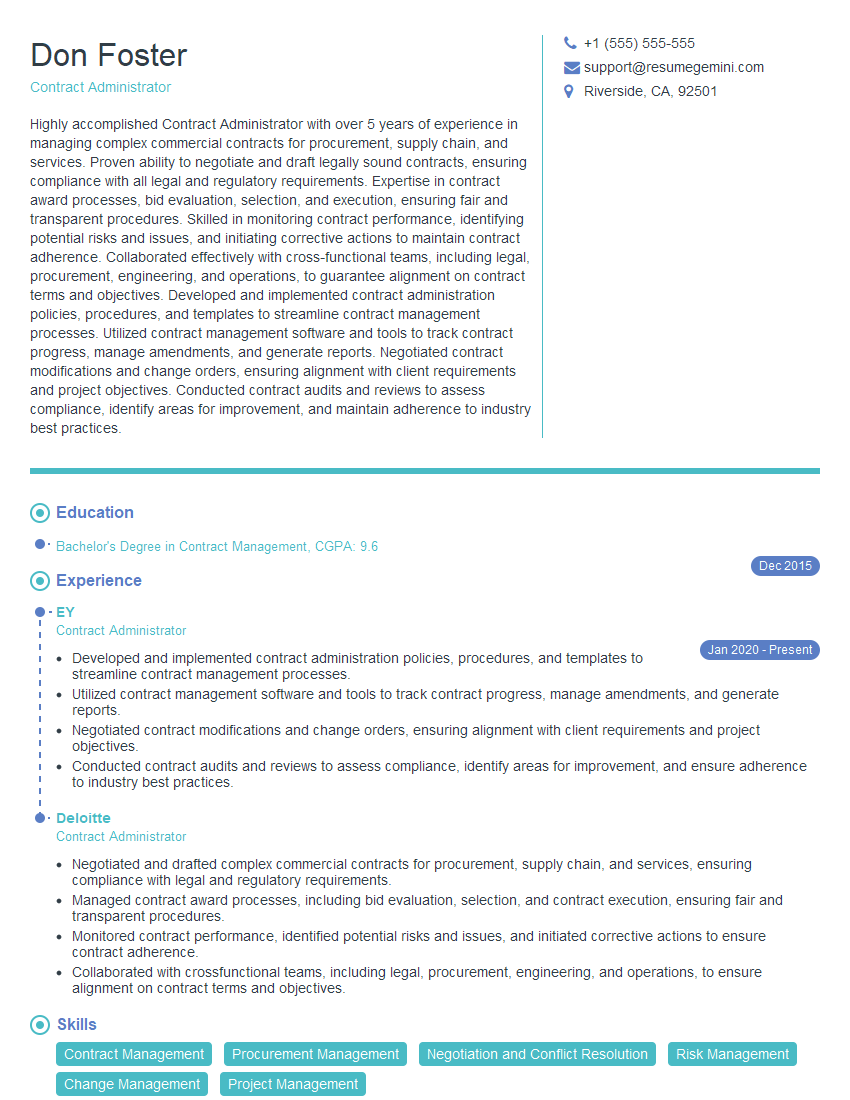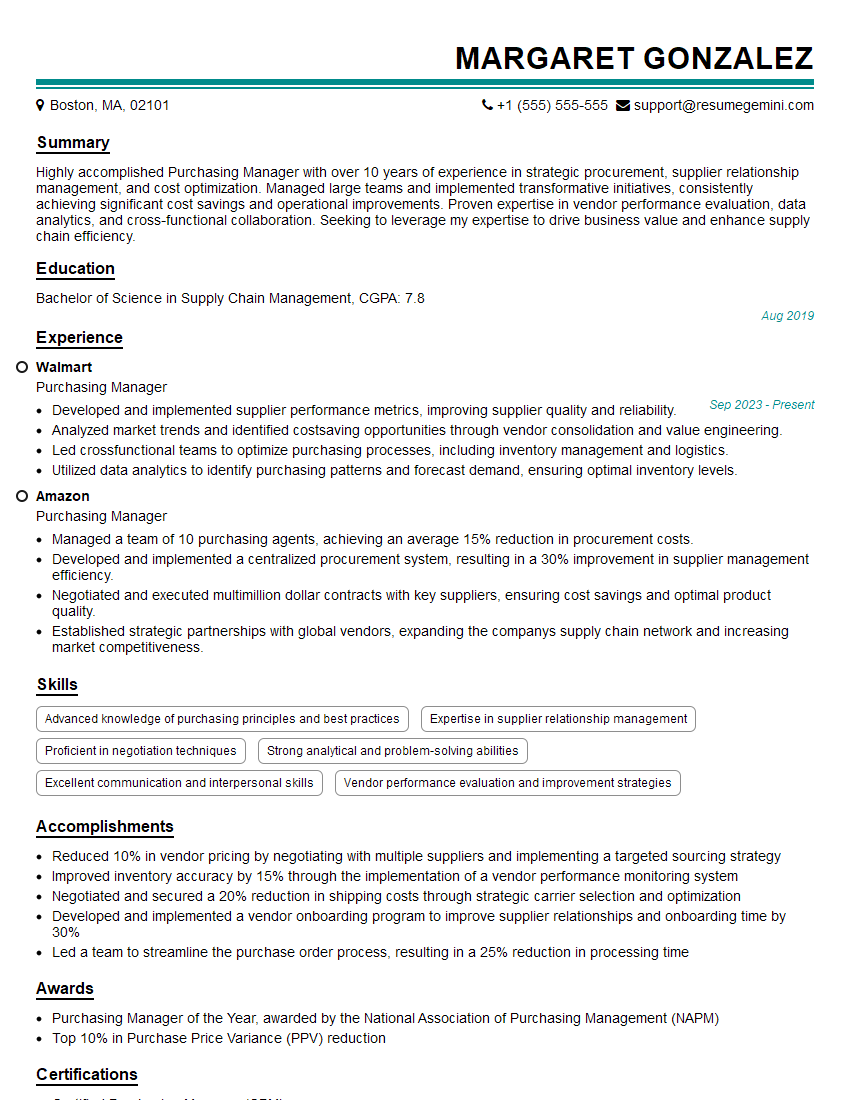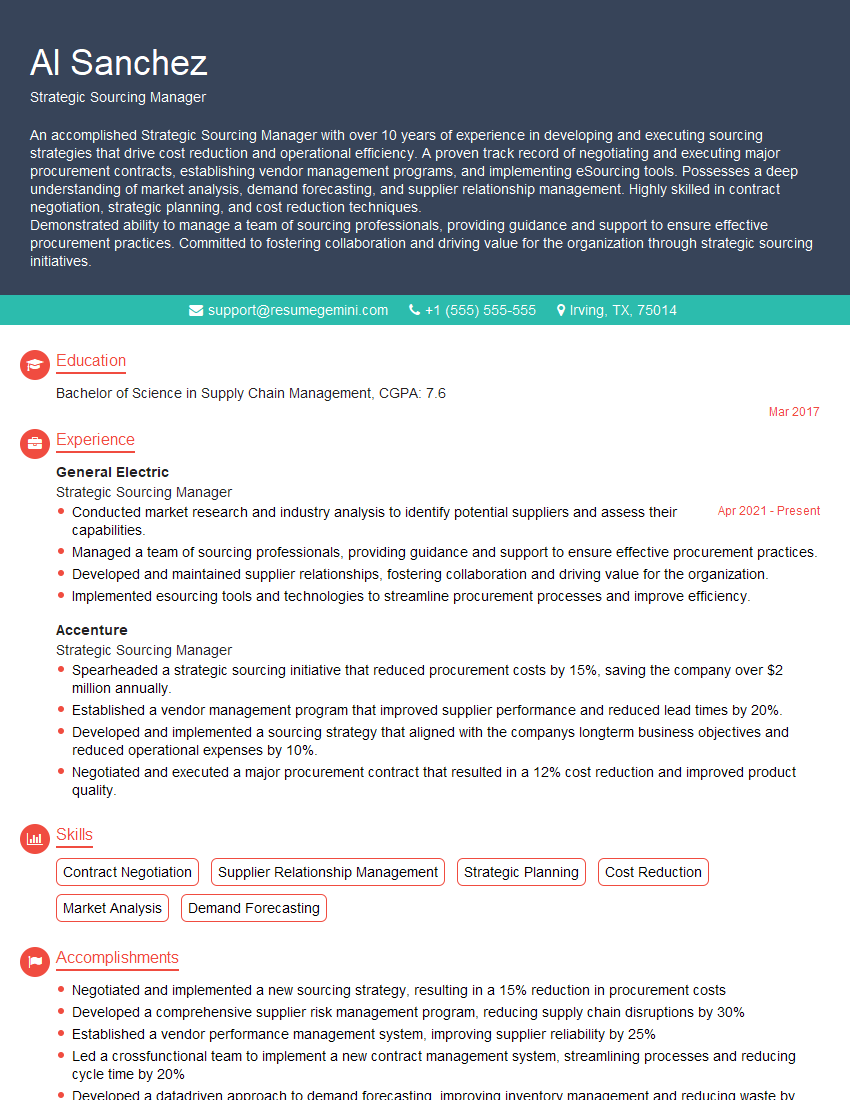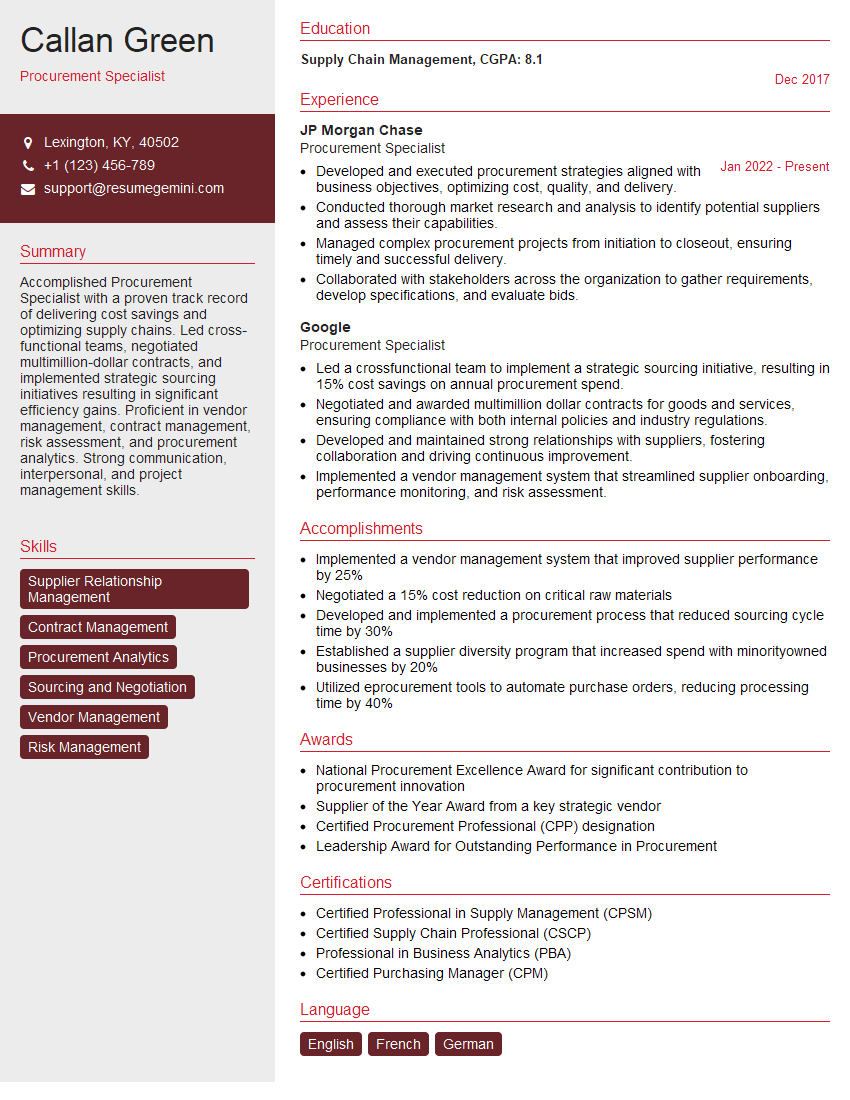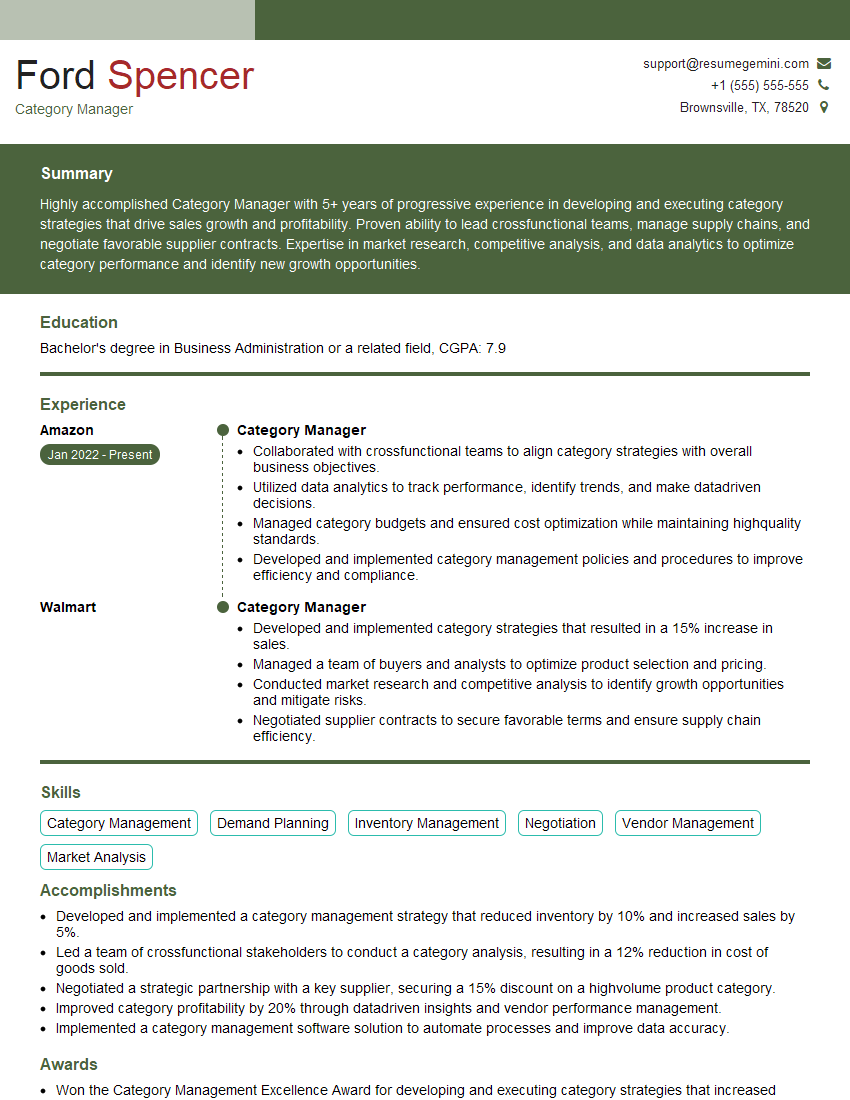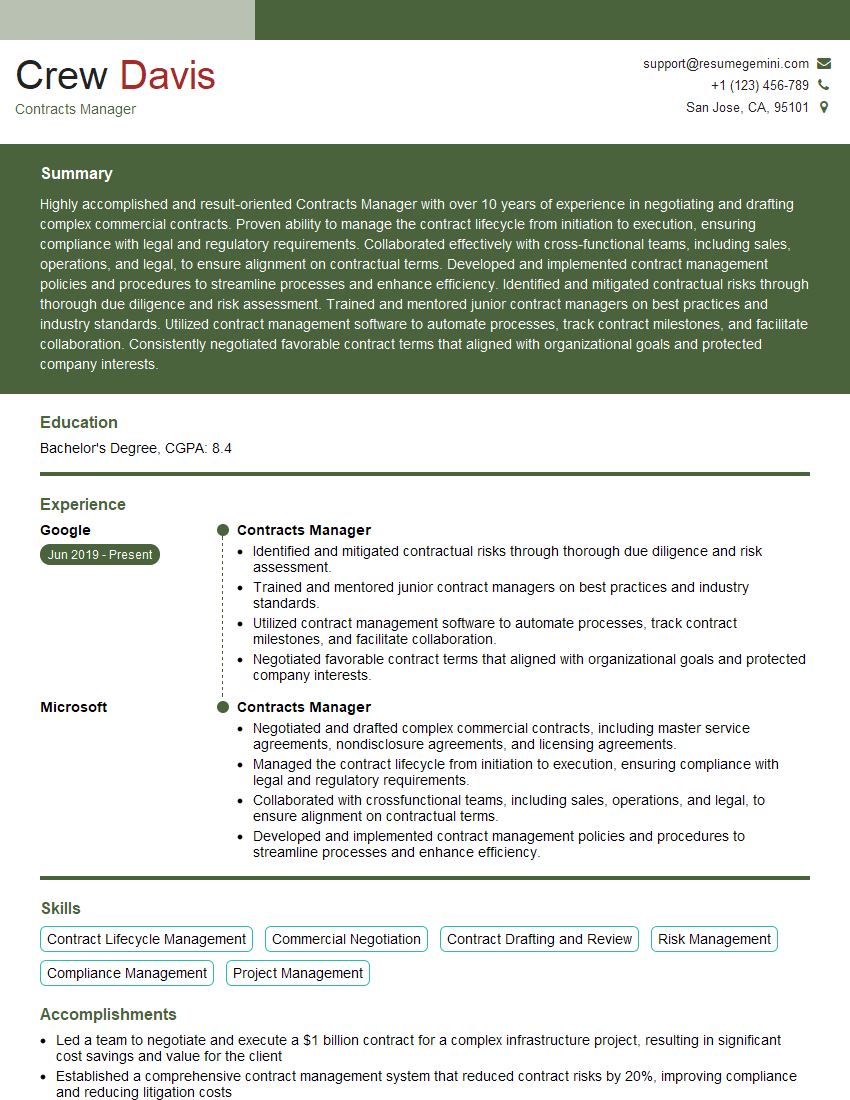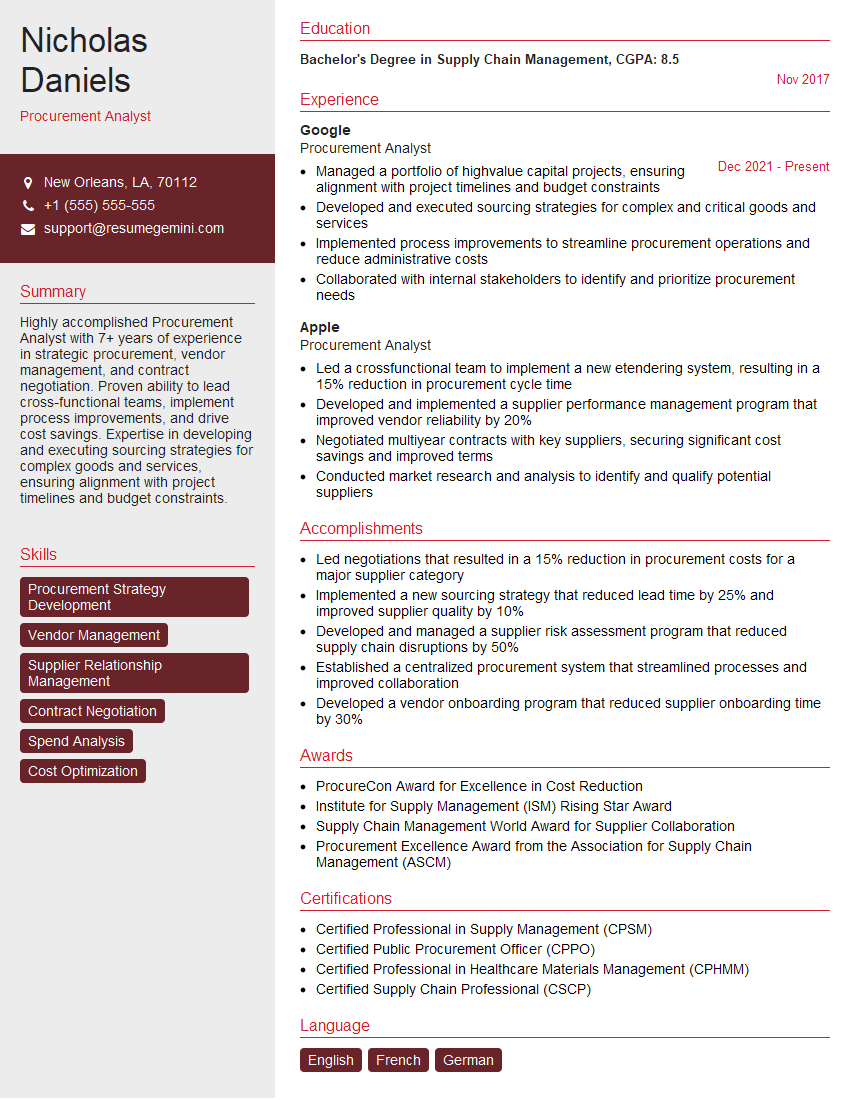Every successful interview starts with knowing what to expect. In this blog, we’ll take you through the top Tendering and Procurement interview questions, breaking them down with expert tips to help you deliver impactful answers. Step into your next interview fully prepared and ready to succeed.
Questions Asked in Tendering and Procurement Interview
Q 1. Explain the process of developing a tender document.
Developing a robust tender document is crucial for a successful procurement process. It’s like writing a detailed recipe for a complex dish – leaving nothing to chance. The process typically involves several key stages:
- Needs Analysis & Specification: Clearly define what you need. This includes specifying the required goods, services, or works, quantifying them, and outlining technical specifications and quality standards. For example, if procuring laptops, you’d specify the processor, RAM, storage, and operating system required.
- Budget Determination: Establish a realistic budget considering all costs, including potential contingencies. This will guide the entire procurement process.
- Tender Document Preparation: This is the core of the process. The document should include:
- Introduction and Instructions: Clear guidelines for bidders.
- Scope of Work: A comprehensive description of the project or requirement.
- Technical Specifications: Detailed requirements for the goods/services.
- Evaluation Criteria: How bids will be assessed (e.g., price, quality, experience).
- Submission Instructions: Deadline, format, and required documentation.
- Contractual Terms: Key clauses related to payment, warranties, and liabilities.
- Legal Review: Ensure the document is legally sound and compliant with all relevant regulations. This often involves legal counsel.
- Publication and Distribution: Disseminate the tender document widely to reach potential suppliers.
A well-structured tender document minimizes ambiguity, ensures fair competition, and promotes transparency, ultimately leading to a better outcome.
Q 2. Describe your experience with different procurement methods (e.g., competitive bidding, negotiation).
I have extensive experience across various procurement methods. Each method has its strengths and weaknesses, requiring a tailored approach depending on the project’s complexity and value.
- Competitive Bidding: This is ideal for standardized goods and services where price is a primary factor. I’ve used this successfully for procuring office supplies, where multiple suppliers submit sealed bids, and the lowest compliant bid is selected. It’s transparent and efficient but may not always prioritize quality over cost.
- Negotiation: This method is best suited for complex procurements requiring customized solutions or where a long-term relationship with the supplier is desired. I’ve used negotiation for IT infrastructure projects, allowing for flexibility in addressing specific requirements and building a collaborative partnership with the supplier. It’s more flexible but requires strong negotiation skills.
- Request for Proposals (RFP): This is commonly used for projects requiring detailed proposals outlining the supplier’s approach and capabilities. I’ve managed several RFPs for software development projects, evaluating proposals based on technical expertise, project methodology, and pricing. It allows for a comprehensive evaluation of the supplier’s capabilities.
- Request for Quotations (RFQ): A more simplified version of an RFP, suitable for straightforward purchases with clearly defined specifications.
Selecting the right method is crucial for achieving the desired outcome while maintaining efficiency and fairness.
Q 3. How do you evaluate supplier bids and select the best option?
Evaluating supplier bids is a systematic process that ensures fairness and transparency. It often involves a weighted scoring system to account for various criteria.
- Compliance Check: First, I verify whether bids meet all the mandatory requirements outlined in the tender document. Non-compliant bids are rejected.
- Technical Evaluation: This assesses the technical aspects of the bid – whether the proposed solution meets the specified technical requirements. This could involve expert reviews and technical demonstrations.
- Commercial Evaluation: This focuses on the pricing, payment terms, and overall cost-effectiveness of the bid.
- Weighted Scoring: Each criterion is assigned a weight reflecting its relative importance. For example, technical aspects might receive 60%, price 30%, and experience 10%. Each bid receives a score based on its performance against each criterion.
- Ranking and Selection: Bids are ranked based on their total weighted scores. The highest-scoring compliant bid is typically selected, although other factors like potential risks might be considered.
This structured approach ensures objectivity and minimizes biases, leading to a well-informed selection decision. Using a clear scoring matrix minimizes subjectivity and enables a defensible selection process.
Q 4. What are the key considerations when negotiating contracts?
Negotiating contracts requires a strategic approach that balances the needs of both parties. Key considerations include:
- Clearly Defined Scope: Ensure the contract accurately reflects the agreed-upon scope of work, preventing future disputes.
- Payment Terms: Establish clear payment milestones and schedules, ensuring timely payments and protecting the buyer’s interests.
- Intellectual Property Rights: Define ownership and usage rights for any intellectual property created or used during the project.
- Liability and Indemnification: Establish clear responsibilities and liabilities for potential issues or damages.
- Confidentiality: Protect sensitive information exchanged during the project.
- Dispute Resolution: Outline a clear process for resolving disputes, ideally through mediation or arbitration to avoid costly litigation.
- Termination Clause: Specify conditions under which the contract can be terminated by either party.
Effective negotiation involves active listening, clear communication, and a collaborative approach. It’s about finding mutually beneficial solutions, not just pursuing individual interests. Think of it as building a partnership, not just a transaction.
Q 5. How do you manage risks associated with procurement?
Risk management is crucial in procurement. Ignoring risks can lead to cost overruns, project delays, and legal issues. I employ a proactive risk management strategy encompassing several steps:
- Risk Identification: This involves identifying potential risks throughout the procurement lifecycle, such as supplier bankruptcy, delays in delivery, or changes in market conditions.
- Risk Assessment: Evaluate the likelihood and potential impact of each identified risk. This could involve qualitative assessments or more quantitative methods.
- Risk Mitigation: Develop strategies to reduce the likelihood or impact of identified risks. This could involve selecting multiple suppliers, implementing rigorous quality control processes, or securing insurance.
- Risk Monitoring and Control: Continuously monitor risks throughout the project and adjust strategies as needed. Regular progress reports and supplier performance reviews are essential.
By proactively identifying and addressing risks, I ensure project success and protect the organization from potential financial and operational setbacks. This often involves contingency planning and clear communication between stakeholders.
Q 6. What are your strategies for cost reduction in procurement?
Cost reduction in procurement is a continuous effort requiring a multi-faceted approach.
- Strategic Sourcing: Exploring alternative suppliers and negotiating better prices through competitive bidding or negotiation.
- Value Engineering: Analyzing the specifications to identify areas where cost savings can be achieved without compromising quality or functionality. This might involve using alternative materials or simplifying designs.
- Volume Discounts: Negotiating favorable pricing by increasing order quantities or consolidating purchases.
- Supply Chain Optimization: Improving efficiency in the supply chain by streamlining processes and reducing lead times.
- Technology Adoption: Utilizing e-procurement systems and automation to reduce administrative costs and improve efficiency.
- Long-Term Contracts: Establishing long-term contracts with reliable suppliers can secure favorable pricing and predictable supply.
The key is to find a balance between cost reduction and maintaining quality and ensuring the ongoing supply of necessary goods and services. Cost reduction shouldn’t compromise the overall project goals.
Q 7. Explain your experience with e-procurement systems.
I possess significant experience with e-procurement systems, having implemented and managed several such systems. These systems offer numerous advantages, including increased efficiency, improved transparency, and reduced costs.
- Streamlined Processes: E-procurement automates many manual tasks, such as purchase order generation, invoice processing, and supplier communication.
- Improved Transparency and Traceability: The entire procurement process is documented electronically, providing a complete audit trail and improving transparency.
- Reduced Costs: Automation reduces administrative overhead and minimizes errors, leading to cost savings.
- Enhanced Collaboration: E-procurement platforms facilitate seamless communication and collaboration between buyers and suppliers.
- Better Data Analysis: The data collected by e-procurement systems allows for improved analysis of spending patterns and supplier performance.
For example, in a previous role, we implemented an e-procurement system that reduced processing time for purchase orders by 50% and decreased invoice processing errors by 75%. Selecting and implementing the right e-procurement system requires careful consideration of the organization’s needs and integration with existing systems. This includes careful change management to ensure user adoption and system success.
Q 8. How do you ensure compliance with relevant regulations in procurement?
Ensuring compliance in procurement is paramount. It involves a multi-faceted approach focused on adhering to all relevant laws, regulations, and internal policies. This includes understanding and following rules related to public procurement (like the EU’s Procurement Directives or similar national legislation), anti-bribery laws (like the UK Bribery Act or the US Foreign Corrupt Practices Act), and data protection regulations (like GDPR).
My approach involves:
- Proactive Due Diligence: Before initiating any procurement process, I thoroughly research and understand all applicable regulations. This often includes consulting legal counsel to interpret ambiguous clauses or address specific concerns.
- Transparent Documentation: Every step of the procurement process, from tender preparation to contract award, is meticulously documented. This includes records of all communications, evaluations, and decisions. This trail of evidence is vital for demonstrating compliance.
- Regular Audits and Reviews: I advocate for regular internal audits and compliance reviews to identify potential weaknesses and ensure consistent adherence to regulations. External audits are also beneficial, offering an independent assessment.
- Training and Awareness: Training all stakeholders, including procurement officers and suppliers, on relevant regulations is crucial. A well-informed team is more likely to proactively identify and avoid compliance breaches.
- Risk Management: Identifying and mitigating potential risks is critical. This might involve implementing robust supplier vetting procedures to screen for potential corruption or non-compliance issues.
For example, in a recent project involving public sector procurement, I ensured strict adherence to the specific bidding guidelines and evaluation criteria, meticulously documenting every step to avoid any allegations of bias or favoritism. The result was a successful and legally sound procurement process.
Q 9. Describe your experience with supplier relationship management.
Supplier Relationship Management (SRM) is crucial for long-term success in procurement. It’s about building and maintaining strong, mutually beneficial relationships with key suppliers. Instead of viewing suppliers as mere vendors, SRM focuses on fostering collaboration, transparency, and mutual value creation.
My experience in SRM includes:
- Supplier Segmentation: I segment suppliers based on their criticality and strategic importance. This allows for a tailored approach, investing more time and resources in managing strategic suppliers.
- Performance Monitoring: I establish clear Key Performance Indicators (KPIs) and regularly monitor supplier performance against those metrics. This enables proactive identification of potential issues and allows for timely interventions.
- Collaborative Problem Solving: When issues arise, I focus on collaborating with suppliers to find mutually acceptable solutions, fostering a culture of partnership rather than confrontation.
- Regular Communication: Open and regular communication is vital. I maintain frequent contact with key suppliers, attending meetings and engaging in open dialogue to understand their challenges and proactively address concerns.
- Negotiation and Contract Management: I am skilled in negotiating favorable terms and conditions while ensuring fairness and mutual benefit. Effective contract management ensures compliance and minimizes disputes.
In one instance, by proactively working with a key supplier facing capacity constraints, we collaborated to find an alternative solution, preventing project delays and cost overruns. This proactive approach strengthened our relationship and demonstrated the value of strategic SRM.
Q 10. How do you handle disputes or conflicts with suppliers?
Handling disputes with suppliers requires a methodical and professional approach. The goal is always to resolve conflicts fairly and efficiently, minimizing disruption to projects and maintaining positive long-term relationships where possible.
My approach involves:
- Early Intervention: Addressing issues as soon as they arise is key. This often involves informal communication to understand the supplier’s perspective and seek a mutually acceptable solution.
- Formal Dispute Resolution: If informal attempts fail, I escalate the issue to formal dispute resolution mechanisms outlined in the contract, such as mediation or arbitration. This allows for a neutral third party to facilitate a resolution.
- Documentation: Maintaining comprehensive records of all communications and agreements is crucial for supporting a claim or defending against one.
- Legal Counsel: For complex or high-stakes disputes, I consult with legal counsel to ensure compliance with relevant laws and to protect the organization’s interests.
- Collaboration: Even during a dispute, I strive to maintain a professional and collaborative approach. Focusing on finding a mutually acceptable solution, even when disagreements exist, helps preserve the long-term relationship.
For example, in a past project, a disagreement over payment terms was resolved amicably through mediation. This approach prevented a costly and time-consuming court battle while preserving a valuable supplier relationship.
Q 11. What is your experience with performance management of suppliers?
Supplier performance management is a continuous process aimed at ensuring that suppliers consistently meet the agreed-upon terms and conditions of their contracts. It involves setting clear expectations, monitoring performance, and taking corrective action when necessary.
My experience encompasses:
- KPI Development and Monitoring: I work with suppliers to define relevant KPIs that align with business objectives. These KPIs are regularly tracked and analyzed to assess performance.
- Performance Reviews: Regular performance reviews are conducted with suppliers, providing constructive feedback and identifying areas for improvement.
- Incentive Programs: I often implement incentive programs to reward high-performing suppliers and motivate them to continue delivering excellent results.
- Corrective Actions: When performance falls short, I work collaboratively with suppliers to identify the root causes and implement corrective actions. This may involve providing training, technical assistance, or implementing improvement plans.
- Supplier Development: I believe in fostering long-term partnerships by supporting supplier development. This might involve providing guidance on improving processes, technology, or quality control.
For instance, by implementing a performance improvement plan with a lagging supplier, we were able to identify and address bottlenecks in their production process, significantly improving their delivery times and quality.
Q 12. How do you manage procurement projects effectively?
Effective procurement project management requires a structured approach that ensures projects are completed on time, within budget, and to the required quality standards. It involves careful planning, execution, monitoring, and control.
My approach uses a project management framework (like PRINCE2 or Agile) and includes:
- Clear Project Definition: A well-defined project scope, objectives, and deliverables are essential. This clarity ensures that all stakeholders understand what needs to be achieved.
- Detailed Planning: This involves developing a detailed project plan, outlining tasks, timelines, resources, and budgets. Risk assessment and mitigation planning are also crucial.
- Vendor Selection: A rigorous vendor selection process ensures that suppliers are capable and reliable. This involves evaluating their qualifications, experience, and financial stability.
- Contract Management: Proper contract management is crucial to ensure that agreements are adhered to and disputes are minimized.
- Monitoring and Control: Regular progress monitoring and control mechanisms are needed to track performance against the plan and make adjustments as required.
- Communication: Effective communication is essential to keep all stakeholders informed of progress and any potential issues.
In a recent infrastructure project, employing a phased approach and rigorous monitoring ensured timely delivery and cost-effective procurement, avoiding common pitfalls like scope creep and budget overruns.
Q 13. Explain your understanding of total cost of ownership (TCO).
Total Cost of Ownership (TCO) is a holistic approach to evaluating the overall cost of acquiring and using a product or service over its entire lifecycle. It extends beyond the initial purchase price to include all associated costs, providing a more comprehensive understanding of true value.
TCO typically includes:
- Acquisition Costs: The initial purchase price of the product or service.
- Operating Costs: Costs associated with using the product or service, such as maintenance, repairs, energy consumption, and staffing.
- Disposal Costs: Costs associated with disposing of or retiring the product or service at the end of its useful life.
Understanding TCO helps organizations make informed procurement decisions by comparing the total cost of different options, rather than focusing solely on the upfront price. For example, a product with a lower initial price might have higher operating costs, making it less cost-effective in the long run. A thorough TCO analysis can reveal these hidden costs and guide procurement decisions towards the most economically viable option.
Q 14. How do you ensure the quality of goods and services procured?
Ensuring the quality of goods and services is paramount in procurement. It involves implementing a robust quality assurance system that covers all stages of the procurement process.
My approach includes:
- Clear Quality Specifications: Detailed and unambiguous specifications are essential to ensure that suppliers understand the required quality standards. This often involves using industry standards and best practices.
- Supplier Selection: Choosing suppliers with a proven track record of quality and compliance is crucial. This may involve conducting thorough supplier audits and assessments.
- Quality Control Inspections: Implementing quality control inspections at various stages of the procurement process helps to identify defects early and prevent them from reaching the end-user.
- Acceptance Testing: Formal acceptance testing ensures that goods and services meet the required specifications before final acceptance.
- Performance Monitoring: Ongoing performance monitoring helps to identify and address any quality issues that may arise after delivery.
- Continuous Improvement: A culture of continuous improvement is essential to ensure that quality standards are consistently met and improved over time.
For example, in a recent project involving the procurement of IT equipment, we implemented a rigorous testing and inspection process to ensure that all equipment met the required specifications and was free from defects. This proactive approach prevented delays and ensured the smooth implementation of the project.
Q 15. Describe your experience with different contract types (e.g., fixed-price, time and materials).
My experience spans various contract types, each suited for different project needs. Fixed-price contracts, for instance, are ideal for projects with well-defined scopes where the price is agreed upon upfront. This minimizes cost risk for the buyer but requires meticulous upfront planning to account for all potential contingencies. I’ve used these successfully for IT infrastructure upgrades, where the specifications were clearly laid out. In contrast, Time and Materials (T&M) contracts are better for projects with evolving requirements or where the full scope isn’t initially clear. This approach offers flexibility but increases the risk of cost overruns if not managed carefully. I successfully employed a T&M contract for a software development project where the client’s needs refined throughout the process. Finally, Cost-plus contracts, which involve reimbursing the supplier for their costs plus a predetermined markup, are used when uncertainty is high, like in research and development projects. I’ve found that robust change management processes are vital for all contract types to minimize disputes and ensure transparency.
Each contract type involves specific risk mitigation strategies. For fixed-price, this includes detailed specifications and thorough change management processes. For T&M, it’s about regular progress meetings, robust tracking of time and materials, and clear acceptance criteria for deliverables. Cost-plus requires rigorous cost accounting and auditing procedures.
Career Expert Tips:
- Ace those interviews! Prepare effectively by reviewing the Top 50 Most Common Interview Questions on ResumeGemini.
- Navigate your job search with confidence! Explore a wide range of Career Tips on ResumeGemini. Learn about common challenges and recommendations to overcome them.
- Craft the perfect resume! Master the Art of Resume Writing with ResumeGemini’s guide. Showcase your unique qualifications and achievements effectively.
- Don’t miss out on holiday savings! Build your dream resume with ResumeGemini’s ATS optimized templates.
Q 16. How do you identify and mitigate potential supply chain disruptions?
Identifying and mitigating supply chain disruptions requires a proactive and multi-faceted approach. Think of it like building a resilient network. First, I conduct risk assessments, analyzing potential disruptions such as natural disasters, political instability, or supplier bankruptcy. This involves mapping the entire supply chain to identify single points of failure. For example, relying heavily on a single supplier for a critical component is a major risk. Next, I implement diversification strategies—spreading risk across multiple suppliers, geographical locations, and even alternative materials or technologies. I also build strong supplier relationships, fostering open communication and collaboration to anticipate potential issues early on. This often involves regular performance reviews and joint risk mitigation planning sessions. Finally, I leverage inventory management techniques, such as maintaining safety stock or establishing strategic warehousing. During the recent global chip shortage, for example, I worked with a client to build buffer stock of key components, ensuring project continuity despite the disruption. Effective communication and collaboration are key— keeping all stakeholders informed and engaged throughout the process.
Q 17. What is your experience with strategic sourcing?
Strategic sourcing goes beyond simply finding the lowest price; it’s about aligning procurement with overall business objectives. It’s about looking at the bigger picture. My experience involves developing a long-term vision for procurement, focusing on cost reduction, quality improvement, and risk mitigation. I’ve led several initiatives involving market analysis, supplier selection, and negotiation strategies. For instance, in one project, I identified a new supplier offering a superior product at a lower cost, leading to significant savings and improved product quality. This involved a thorough analysis of the supplier’s capabilities, financial stability, and ethical practices. Another example is implementing a total cost of ownership (TCO) analysis, which considers not just the initial purchase price but all related costs like maintenance, transportation, and disposal. This approach enables more informed decision-making, optimizing value beyond the immediate cost. Ultimately, strategic sourcing aims to create a competitive advantage for the organization.
Q 18. How do you measure the success of your procurement activities?
Measuring procurement success isn’t just about cost savings; it requires a holistic approach. I use a balanced scorecard, considering both financial and non-financial metrics. Key Performance Indicators (KPIs) I commonly track include cost savings (percentage reduction compared to previous years), supplier performance (on-time delivery, quality metrics), contract compliance (adherence to contract terms), and stakeholder satisfaction (feedback from internal clients). I also track efficiency metrics like the procurement cycle time (time taken to complete a procurement process from initiation to completion). For example, implementing a new e-procurement system reduced our cycle time by 30%, freeing up resources and improving efficiency. I regularly report on these KPIs, using data visualization tools to present insights to stakeholders, facilitating data-driven decision-making and highlighting areas for improvement. The most important aspect is to tailor the metrics to reflect the specific goals of the organization and the nature of procurement activities.
Q 19. Describe your experience with developing and implementing procurement policies.
Developing and implementing procurement policies requires a comprehensive approach that encompasses several key steps. I start by identifying the organization’s strategic goals, then align procurement policies to support these objectives. The policies cover areas such as supplier selection criteria (financial stability, ethical conduct, quality certifications), contract management procedures, risk management strategies, and compliance requirements (legal and regulatory). It also includes guidelines for e-procurement, invoice processing, and dispute resolution. I’ve spearheaded the development of such policies for several organizations, ensuring compliance with relevant laws and regulations. For example, I implemented a policy emphasizing sustainable procurement practices, favoring suppliers committed to environmental responsibility and ethical labor practices. Effective policy implementation relies on clear communication, comprehensive training, and regular reviews and updates to ensure policies remain relevant and effective.
Q 20. How do you stay updated with the latest trends in procurement?
Staying current in the dynamic field of procurement requires continuous learning and engagement. I actively participate in professional organizations like the Institute for Supply Management (ISM), attending conferences and webinars to learn about emerging trends and best practices. I regularly read industry publications, journals, and online resources to stay informed about innovative technologies and evolving regulatory landscapes. I also network with other procurement professionals, exchanging knowledge and insights. Furthermore, I encourage ongoing professional development for my team, fostering a culture of learning and continuous improvement within our procurement department. Finally, I closely monitor market trends, technological advancements (e.g., artificial intelligence in procurement), and regulatory changes, adapting our strategies accordingly to maintain a competitive edge.
Q 21. What is your experience with different procurement software tools?
My experience with procurement software tools is extensive. I’m proficient in various systems, including e-procurement platforms (e.g., Coupa, Ariba), supplier relationship management (SRM) systems, and contract management software. These tools streamline various aspects of procurement, from requisitioning and sourcing to contract management and payment processing. For example, implementing an e-procurement system significantly reduced paperwork, improved efficiency, and enhanced transparency. SRM systems help in managing relationships with key suppliers, ensuring timely communication and performance monitoring. Contract management software helps us efficiently track contract performance, compliance, and renewal dates. The selection of software is driven by specific organizational needs and budget considerations; the ideal system integrates seamlessly with existing ERP and other business systems to optimize overall efficiency.
Q 22. How do you ensure ethical and sustainable procurement practices?
Ensuring ethical and sustainable procurement practices is paramount. It’s about more than just getting the best price; it’s about building a responsible supply chain that benefits all stakeholders – from suppliers to the end consumer and the environment. This involves a multi-pronged approach.
- Implementing a robust code of conduct: This clearly outlines ethical expectations for all parties involved in the procurement process, including suppliers, employees, and contractors. It covers areas such as bribery, corruption, fair labor practices, and environmental responsibility. For instance, we might explicitly forbid working with suppliers known to engage in child labor or unsustainable logging practices.
- Due diligence and supplier assessment: Thoroughly vetting potential suppliers before awarding contracts is crucial. This involves examining their ethical and environmental credentials, including certifications like ISO 14001 (environmental management) and SA8000 (social accountability). We use questionnaires, site visits, and third-party audits to gather evidence and assess risk.
- Promoting transparency and accountability: Open and transparent procurement processes minimize opportunities for corruption. This includes publishing procurement plans, tender documents, and award decisions publicly (where appropriate) and maintaining detailed records of all transactions. We utilize electronic procurement systems to maintain an auditable trail.
- Integrating sustainability criteria into tender evaluations: Instead of focusing solely on price, we incorporate environmental and social factors into our scoring systems. This incentivizes suppliers to adopt sustainable practices. For example, we might award points for suppliers using recycled materials, reducing their carbon footprint, or adhering to fair trade principles.
- Continuous improvement and monitoring: Ethical and sustainable procurement is an ongoing process, not a one-time event. Regular reviews and audits ensure that our practices remain effective and aligned with evolving best practices. We track key performance indicators (KPIs) such as supplier compliance with ethical and environmental standards and the environmental impact of our purchases.
In essence, ethical and sustainable procurement requires a culture of responsibility and accountability throughout the organization. It’s about proactively minimizing risks, fostering positive relationships with suppliers, and contributing to a more sustainable future.
Q 23. Describe a time you had to make a difficult procurement decision. What was the outcome?
One challenging procurement decision involved choosing between two suppliers for a critical piece of software. Supplier A offered a slightly lower price but had a less established track record and lacked certain key features. Supplier B was more expensive, but they had extensive experience, a strong reputation, and all the necessary features. The deadline was tight, and the software was essential for a major project launch.
The difficult choice was balancing cost-effectiveness with risk mitigation. A cost-benefit analysis showed that the potential disruptions and delays from choosing Supplier A’s inferior software significantly outweighed the initial cost savings. We ultimately selected Supplier B. The outcome was successful. While it was a more expensive initial investment, the project was completed on time and without significant disruptions. Supplier B’s expertise and reliable software ensured a smooth launch, avoiding potential reputational damage and financial losses associated with project delays. This reinforced the importance of considering long-term value and mitigating risk over short-term cost savings in strategic procurement decisions.
Q 24. How do you handle situations where suppliers fail to meet deadlines or specifications?
When suppliers fail to meet deadlines or specifications, a systematic approach is crucial. The first step involves promptly communicating with the supplier to understand the reason for the delay or non-compliance. This often involves reviewing the contract and identifying the specific clauses relating to performance and remedies.
- Identify the root cause: Is it due to unforeseen circumstances, internal issues within the supplier’s organization, or a failure to adequately plan and resource the project? This will dictate the appropriate response.
- Develop a corrective action plan: Collaborate with the supplier to establish a clear plan for rectifying the situation. This might involve extending deadlines (with potential penalties), providing additional resources, or implementing changes to the project scope.
- Monitor progress: Regularly track the supplier’s progress towards meeting the revised deadlines or specifications. This may require more frequent communication and potentially on-site visits.
- Enforce contractual remedies: If the supplier continues to fail to meet expectations despite corrective actions, contractual remedies need to be explored. This might include imposing penalties, withholding payments, or even terminating the contract. The specific steps will depend on the terms outlined in the contract.
Throughout this process, maintaining clear and professional communication with the supplier is essential. The goal is not merely to punish the supplier, but to resolve the issue effectively and ensure the successful completion of the project. This may involve negotiation and compromise to find a mutually acceptable solution. Documentation of all communication and actions taken is critical for maintaining a clear record.
Q 25. Explain your experience with managing procurement budgets.
Managing procurement budgets requires a combination of strategic planning, meticulous tracking, and proactive cost control. It’s more than just allocating funds; it’s about optimizing resource allocation to achieve maximum value for money.
- Budget planning and forecasting: Accurate budget planning begins with a comprehensive understanding of the organization’s procurement needs and associated costs. This involves forecasting future demand and identifying potential cost-saving opportunities. We typically use historical data, market research, and stakeholder input to refine our budget forecasts. This frequently involves using spreadsheet software or specialized procurement software.
- Cost control and monitoring: Tracking actual expenditure against the budget is crucial. Regular monitoring allows for early identification of potential budget overruns and enables corrective action. We leverage financial management systems to automatically generate reports that compare planned vs. actual spending and highlight variances.
- Value for money analysis: Decisions shouldn’t solely focus on the lowest price. We need to consider the whole-life cost of an item or service, including maintenance, operation, and disposal costs. A thorough value for money analysis helps make informed decisions by assessing the overall value of different procurement options.
- Contingency planning: Unexpected costs can arise. A contingency plan that allocates funds to cover unforeseen events allows for flexibility and prevents budget overruns from derailing projects.
- Reporting and accountability: Regular budget reports, highlighting performance against targets, are critical for transparency and accountability. This includes explanations for significant variances and any corrective actions taken.
Effective budget management in procurement is essential for ensuring that resources are utilized efficiently and effectively to achieve organizational objectives. It’s about making strategic decisions, monitoring performance closely, and fostering a culture of accountability.
Q 26. Describe your experience with conducting market research for procurement needs.
Conducting market research for procurement needs is a critical step in ensuring that we obtain the best value for money. It’s about understanding the market landscape, identifying potential suppliers, and assessing their capabilities. The approach is tailored to the specific procurement need, but generally includes these steps:
- Defining requirements: Clearly defining the specifications of the goods or services needed is the starting point. This includes considering factors such as quality, quantity, delivery timelines, and technical specifications.
- Identifying potential suppliers: Various sources are used for identifying potential suppliers. These include online directories, industry publications, trade shows, recommendations from other organizations, and networking. We often use online search engines and specialized procurement databases to find relevant suppliers.
- Gathering information: Once potential suppliers have been identified, the next step involves gathering information on their capabilities, experience, financial stability, and reputation. This may involve reviewing their websites, case studies, and testimonials. Direct contact via phone or email is often valuable.
- Supplier pre-qualification: We may utilize a pre-qualification process to filter out suppliers who do not meet minimum requirements. This may involve completing questionnaires or providing evidence of relevant certifications.
- Market analysis: This step involves analyzing market trends, price fluctuations, and potential risks. It helps in establishing realistic expectations and identifying potential challenges. We may use market research reports or consult with industry experts.
Thorough market research significantly reduces the risk of making poor procurement decisions and helps secure favorable terms and conditions, ensuring that the organization gets the best possible value for its money.
Q 27. What is your understanding of the different types of procurement contracts?
Procurement contracts come in various forms, each with distinct characteristics and implications. The choice of contract type depends on factors such as the complexity of the procurement, the level of risk involved, and the relationship with the supplier.
- Fixed-price contracts: The price is predetermined and fixed throughout the contract duration, offering certainty for both parties. This is suitable for projects with well-defined scope and low risk.
- Cost-plus contracts: The supplier is reimbursed for their actual costs plus a predetermined fee or percentage. This is suitable for projects with uncertain scope or high levels of risk, but requires careful cost monitoring.
- Time and materials contracts: The supplier is paid for the time spent and materials used. This provides flexibility but requires careful tracking of time and materials to avoid cost overruns.
- Framework agreements: These are long-term agreements that establish the general terms and conditions for future procurements. Individual orders are then placed under the framework agreement, simplifying the process. This is beneficial for repeat purchases.
- Indeterminate quantity contracts: The specific quantity of goods or services is not defined upfront, allowing for flexibility in ordering over a specific period.
Selecting the right contract type requires a detailed understanding of the project’s requirements and potential risks. The contract should clearly outline responsibilities, payment terms, dispute resolution mechanisms, and other essential aspects. Legal advice should be sought to ensure that the contract is legally sound and protects the interests of the organization.
Q 28. How do you ensure data integrity and transparency in the procurement process?
Data integrity and transparency are crucial for ethical and efficient procurement. They enhance accountability, reduce the risk of fraud and errors, and build trust with stakeholders.
- Electronic procurement systems: Utilizing electronic procurement systems (e-procurement) enhances data integrity by automating many aspects of the process. This minimizes human error and provides a secure, auditable trail of all transactions.
- Data validation and verification: Implementing robust data validation and verification procedures ensures that data entered into the system is accurate and consistent. This might include using automated checks and validation rules in the e-procurement system.
- Access controls and authorization: Restricting access to procurement data based on roles and responsibilities is crucial to maintain data integrity and prevent unauthorized modifications. This utilizes robust user authentication and authorization mechanisms.
- Data backup and recovery: Regular data backups and disaster recovery plans are essential to protect against data loss or corruption. This should include offsite backups to protect against physical damage or theft.
- Transparency and reporting: Publicly accessible reports and dashboards (where appropriate) improve transparency by allowing stakeholders to monitor procurement activities and identify any potential issues.
- Regular audits: Conducting regular internal and external audits ensures that procurement processes and data management practices comply with regulations and best practices.
By implementing these measures, we ensure that procurement data is accurate, reliable, and accessible, promoting transparency and accountability across the organization.
Key Topics to Learn for Tendering and Procurement Interview
- Procurement Strategy & Planning: Understanding the strategic goals of procurement, developing sourcing strategies, and conducting market research to identify suitable suppliers.
- Supplier Relationship Management (SRM): Building and maintaining strong relationships with suppliers, negotiating contracts, and managing supplier performance.
- Tendering Process & Documentation: Preparing and submitting competitive bids, understanding tender evaluation criteria, and managing the tender lifecycle.
- Contract Negotiation & Management: Mastering negotiation techniques, drafting and reviewing contracts, and managing contract performance and compliance.
- Risk Management in Procurement: Identifying and mitigating potential risks throughout the procurement process, including financial, legal, and reputational risks.
- Public Procurement Regulations & Compliance: Understanding and adhering to relevant legislation and regulations governing public procurement (e.g., EU directives).
- e-Procurement & Technology: Utilizing e-procurement systems and technologies to streamline procurement processes and improve efficiency.
- Cost Analysis & Budgeting: Accurately estimating costs, developing budgets, and monitoring expenditure throughout the procurement lifecycle.
- Ethical Considerations in Procurement: Understanding and applying ethical principles and best practices in all procurement activities, including conflict of interest management.
- Problem-solving & Decision-making in Procurement: Applying analytical skills to solve complex procurement challenges and make informed decisions under pressure.
Next Steps
Mastering Tendering and Procurement opens doors to exciting career opportunities in diverse sectors, offering excellent prospects for growth and advancement. A strong resume is crucial for showcasing your skills and experience to potential employers. Creating an ATS-friendly resume significantly increases your chances of getting noticed by recruiters and landing interviews. We highly recommend using ResumeGemini, a trusted resource, to build a professional and impactful resume that highlights your achievements in Tendering and Procurement. Examples of resumes tailored to this field are available to help you get started.
Explore more articles
Users Rating of Our Blogs
Share Your Experience
We value your feedback! Please rate our content and share your thoughts (optional).
What Readers Say About Our Blog
Interesting Article, I liked the depth of knowledge you’ve shared.
Helpful, thanks for sharing.
Hi, I represent a social media marketing agency and liked your blog
Hi, I represent an SEO company that specialises in getting you AI citations and higher rankings on Google. I’d like to offer you a 100% free SEO audit for your website. Would you be interested?
